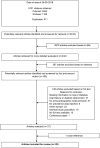The prevalence of left ventricular diastolic dysfunction and heart failure with preserved ejection fraction in men and women with type 2 diabetes: A systematic review and meta-analysis
- PMID: 30037278
- PMCID: PMC6236645
- DOI: 10.1177/1479164118787415
The prevalence of left ventricular diastolic dysfunction and heart failure with preserved ejection fraction in men and women with type 2 diabetes: A systematic review and meta-analysis
Abstract
Objective: Type 2 diabetes is a risk factor for the development of left ventricular diastolic dysfunction and heart failure with preserved ejection fraction. Our aim was to provide a summary estimate of the prevalence of left ventricular diastolic dysfunction and heart failure with preserved ejection fraction in type 2 diabetes patients and to investigate sex disparities.
Methods and results: A systematic search of the databases Medline and Embase was conducted for studies reporting the prevalence of left ventricular diastolic dysfunction or heart failure with preserved ejection fraction among type 2 diabetes patients. Studies were only included if echocardiography was performed. Prevalence estimates were pooled using random-effects meta-analysis. A total of 28 studies were included. Data on the prevalence of left ventricular diastolic dysfunction were available in 27 studies. The pooled prevalence for left ventricular diastolic dysfunction in the hospital population (2959 type 2 diabetes participants) and in the general population (2813 type 2 diabetes participants) was 48% [95% confidence interval: 38%-59%] and 35% (95% confidence interval: 24%-46%), respectively. Heterogeneity was high in both populations, with estimates ranging from 19% to 81% in the hospital population and from 23% to 54% in the general population. For women and men, the pooled prevalence estimates of left ventricular diastolic dysfunction were 47% (95% confidence interval: 37%-58%) and 46% (95% confidence interval: 37%-55%), respectively. Only two studies presented the prevalence of heart failure with preserved ejection fraction; 8% (95% confidence interval: 5%-14%) in a hospital population and 25% (95% confidence interval: 21%-28%) in the general population [18% in men (mean age: 73.8; standard deviation: 8.6) and 28% in women (mean age: 74.9; standard deviation: 6.9)].
Conclusion: The prevalence of left ventricular diastolic dysfunction among type 2 diabetes patients is similarly high in men and women, while heart failure with preserved ejection fraction seems to be more common in women than men, at least in community people with type 2 diabetes.
Keywords: Diabetes; heart failure with preserved ejection fraction; left ventricular diastolic dysfunction; prevalence.
Conflict of interest statement
Figures






References
-
- Bertoni AG, Hundley WG, Massing MW, et al. Heart failure prevalence, incidence, and mortality in the elderly with diabetes. Diabetes Care 2004; 27: 699–703. - PubMed
-
- MacDonald MR, Petrie MC, Varyani F, et al. Impact of diabetes on outcomes in patients with low and preserved ejection fraction heart failure: an analysis of the Candesartan in Heart failure: Assessment of Reduction in Mortality and Morbidity (CHARM) programme. Eur Heart J 2008; 29: 1377–1385. - PubMed
-
- Kannel WB, McGee DL. Diabetes and cardiovascular disease. The Framingham study. JAMA 1979; 241: 2035–2038. - PubMed
-
- Ponikowski P, Voors AA, Anker SD, et al. 2016 ESC guidelines for the diagnosis and treatment of acute and chronic heart failure: The Task Force for the diagnosis and treatment of acute and chronic heart failure of the European Society of Cardiology (ESC) developed with the special contribution of the Heart Failure Association (HFA) of the ESC. Eur Heart J 2016; 37: 2129–2200. - PubMed
-
- Van Riet EES, Hoes AW, Wagenaar KP, et al. Epidemiology of heart failure: the prevalence of heart failure and ventricular dysfunction in older adults over time. A systematic review. Eur J Heart Fail 2016; 18: 242–252. - PubMed
Publication types
MeSH terms
LinkOut - more resources
Full Text Sources
Other Literature Sources
Medical

